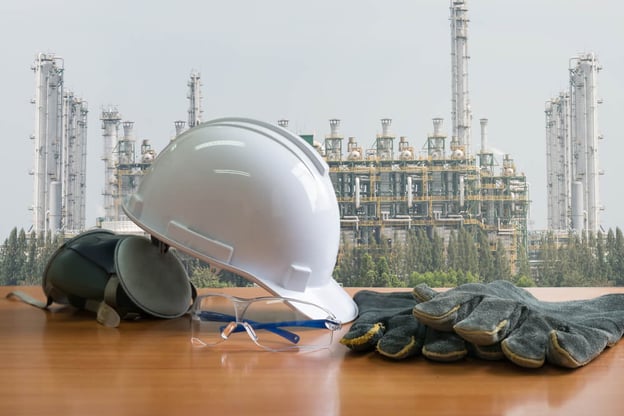Share this
Rotating Equipment Safety Starts With Your Seal Support Systems—Here’s How to Keep Up
by Paul Lesnau on 4/16/20 8:45 AM

Chemical and petroleum plants that rely on motors and pumps to run critical processes must remain laser-focused on rotating equipment safety. This is especially vital in Northern California where operating margins are thinning and consequences of deficiency can be high. Degraded performance or pump failure—especially of aging assets—can result in leakage that jeopardizes employee health and safety, violates Bay Area Air Quality Management District (BAAQMD) regulations, results in substandard products, or impacts efficiency throughout the production line.
Many factors contribute to pump leakage but the two fundamental reasons are:
- lapped seal faces that fail to maintain their alignment
- particulates/ solids that embed in the softer carbon or graphite seal face and gradually degrade the hard seal face
Of course, the severity and impact of leakage are tied to the type of fluid leaking, volume, and surrounding infrastructure that could be impacted by the leak. Toxic fumes and flammable gases or puddles present significant safety risks, if not immediately discovered and mitigated.
Because the condition of mechanical seals is critical to preventing fluid leakage, reliability engineers should continually evaluate pumps and their seal support systems throughout the plant. For many refineries, there’s a fine balance between operational and capital budgets, but a careful review of pumps, based on process criticality, installation date, and repair records is likely to identify pumps needing an upgrade or replacement of their seal support systems. A timely capital investment today often leads to significant future savings.
Improve Rotating Equipment Safety With Targeted Updates and Replacements
To help you understand why a review of aging assets is beneficial, consider some of the capabilities and improvements that help reduce the risk of seal failure and leakage and boost rotating equipment safety. Today’s seal support systems offer a wide range of designs, instrumentation, and options that improve their ability to maintain a seal chamber environment, provide advanced warning of problems, and prevent leakage significantly better than the systems that may have been installed a decade or more ago.
- Tubing configurations eliminate threaded joints as much as possible to reduce the chance of leakage of flush and barrier fluids and buffer gases. Smooth radial bends and proper tubing diameters ensure optimal flow through seal chambers. Vents and drains are located for easy access to facilitate efficient maintenance and operator safety.
- Temperature gauges provide another means of identifying degrading seal performance. The type of flush fluid, coolers, pressure, and rate of flow into the seal chamber all affect temperature. A gradual increase in temperature indicates one or more components are performing suboptimally and require a diagnosis. Elevated temperatures can result in fluid vaporizing across the seal faces, opening the seal, allowing particulates to enter and damage seal faces.
- Seal support systems offer several options to minimize or eliminate particulate damage that may lead to seal failure and leakage. The simplest method uses a strainer to remove particulates from process fluids used to flush the seal chamber. A more sophisticated method employs a cyclone separator that delivers clean fluid to the seal chamber and returns solids to pump suction. An alternative provides clean flush from an external source to ensure a higher pressure in the seal chamber, allowing the flush fluid to migrate past a throat bushing into the process fluid.
- Cooling options offer reliability engineers methods to contend with seal chamber environments whose temperatures are nearing or exceeding operational limits, perhaps as a result of recent process modifications. Process flush obtained from discharge and flowed through a cooler provides better control of the vapor margin. Process fluids circulated from the seal chamber to a cooler then back to the seal chamber provide more efficient usage of cooling energy.
Design improvements and plan options offered by newer seal support systems give reliability and rotating equipment engineers the opportunity to select and deploy solutions that much more closely meet the current process-specific requirements of the plant. Whether you need a system component update or a complete replacement, carefully matching seal support systems to specific process needs helps ensure an optimal seal chamber environment. This is fundamental to preventing seal failure and enhancing rotating equipment safety.
Rely on Local Expertise for Rotating Equipment Improvement Opportunities
Considering the variety of pumps and processes throughout your plant, determining the best seal support systems for your various pumping processes can be daunting. Guidance from a local Northern California seal support systems vendor can help you identify the appropriate component upgrades and determine where a system replacement provides the greatest benefit. You will get the most advantage by choosing a vendor that can also design, fabricate, and test the systems prior to delivery.
Swagelok brings years of industry-specific experience in delivering best-in-class seal support systems—but our support doesn’t end there. Our expert team is local to Bay Area refinery operations, providing immediate access for technical support and rapid delivery of spares—all critical capabilities to help you maintain rotating equipment safety.
To find out more about how Swagelok Northern California can help you ensure rotating equipment safety through expert consultation, custom design, and local fabrication for seal support systems, contact our team today by calling 510-933-6200.
 About Paul Lesnau | Sales Manager, Business Development Manager, and Field Engineer
About Paul Lesnau | Sales Manager, Business Development Manager, and Field Engineer
Paul holds a B.S. in Mechanical Engineering from North Dakota State University. Before joining Swagelok Northern California, he was the West Coast Regional Sales Manager for an organization based in Illinois involved in pneumatic and hydraulic applications where he supervised product distribution throughout the western United States, Canada, and Mexico. While in this role, he was able to help provide technical and application-specific expertise to customers and distribution to drive specifications.
Share this
- Archive (465)
- Assembly Services (207)
- About (100)
- Seal Support Systems (96)
- Best Practices (88)
- Training Services (74)
- Fittings (51)
- Semiconductor Applications (49)
- Hoses and Flexible Tubing (47)
- Regulators (44)
- Tubing (42)
- Grab Sampling Systems (32)
- Sampling Systems (32)
- Gas Systems (30)
- Services (30)
- Downloads (29)
- Valves (24)
- Application Support (18)
- Orbital Welding (17)
- Case Studies (13)
- Steam Systems (13)
- Frequently Asked Questions (12)
- Tools (12)
- Measurement Devices (7)
- Subsystems (6)
- Thermal Management (6)
- September 2023 (1)
- August 2023 (2)
- June 2023 (1)
- March 2023 (3)
- February 2023 (3)
- January 2023 (4)
- December 2022 (4)
- November 2022 (4)
- October 2022 (4)
- September 2022 (1)
- August 2022 (3)
- July 2022 (2)
- June 2022 (4)
- May 2022 (1)
- April 2022 (2)
- March 2022 (1)
- February 2022 (2)
- January 2022 (3)
- December 2021 (1)
- November 2021 (6)
- October 2021 (6)
- September 2021 (8)
- August 2021 (4)
- July 2021 (3)
- June 2021 (6)
- May 2021 (6)
- April 2021 (7)
- March 2021 (5)
- February 2021 (4)
- January 2021 (6)
- December 2020 (5)
- November 2020 (6)
- October 2020 (6)
- September 2020 (8)
- August 2020 (7)
- July 2020 (8)
- June 2020 (8)
- May 2020 (6)
- April 2020 (9)
- March 2020 (7)
- February 2020 (10)
- January 2020 (21)
- December 2019 (23)
- November 2019 (21)
- October 2019 (22)
- September 2019 (21)
- August 2019 (22)
- July 2019 (23)
- June 2019 (20)
- May 2019 (23)
- April 2019 (22)
- March 2019 (21)
- February 2019 (20)
- January 2019 (21)
- December 2018 (14)
- November 2018 (19)
- October 2018 (23)
- September 2018 (17)
- August 2018 (29)
- July 2018 (11)
- June 2018 (6)
- May 2018 (5)
- April 2018 (4)
- March 2018 (5)
- February 2018 (3)
- January 2018 (3)
- December 2017 (2)
- November 2017 (4)
- October 2017 (3)
- September 2017 (2)
- August 2017 (6)
- July 2017 (4)
- June 2017 (4)
- May 2017 (4)
- April 2017 (3)
- March 2017 (4)
- February 2017 (3)
- January 2017 (3)
- December 2016 (3)
- November 2016 (3)
- October 2016 (3)
- September 2016 (5)
- August 2016 (5)
- July 2016 (4)
- June 2016 (5)
- May 2016 (3)
- April 2016 (4)
- March 2016 (5)
- February 2016 (11)
- January 2016 (1)
- December 2015 (3)
- November 2015 (4)
- October 2015 (3)
- September 2015 (4)
- August 2015 (4)
- July 2015 (8)
- June 2015 (5)
- May 2015 (3)
- April 2015 (4)
- March 2015 (4)
- February 2015 (3)
- January 2015 (4)
- December 2014 (2)
- November 2014 (3)
- October 2014 (4)
- September 2014 (4)
- August 2014 (4)
- July 2014 (5)
- June 2014 (4)
- May 2014 (4)
- April 2014 (5)
- March 2014 (4)
- February 2014 (3)
- January 2014 (4)
- December 2013 (5)
- November 2013 (3)
- October 2013 (4)
- September 2013 (3)
- August 2013 (5)
- July 2013 (5)
- June 2013 (5)
- May 2013 (3)
- April 2013 (6)
- March 2013 (4)
- February 2013 (4)
- January 2013 (8)
- December 2012 (4)
- November 2012 (6)
- October 2012 (6)
- September 2012 (4)
- August 2012 (4)
- July 2012 (4)
- June 2012 (4)

.webp?width=210&height=70&name=StickyLogo%20(5).webp)